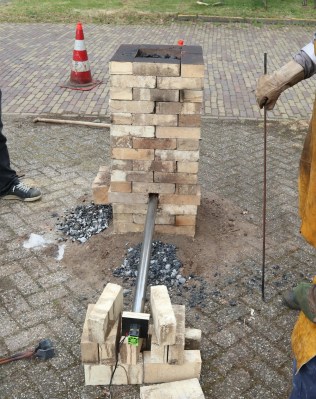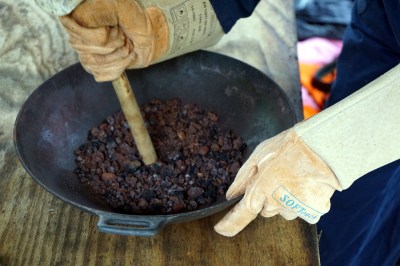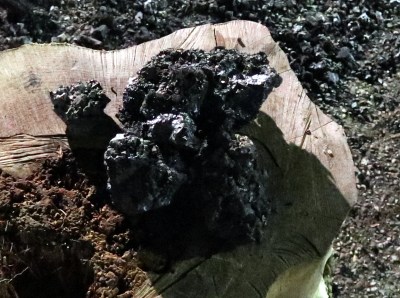When I went to a hacker camp in the Netherlands in February I was expecting to spend a few days in a comfortable venue with a bunch of friends, drink some beer, see a chiptune gig, and say “Ooh!” a lot at the exciting projects people brought along. I did all of those things, but I also opened the door to something unexpected. The folks from RevSpace in the Hague brought along their portable forge, and before long I found myself working a piece of hot rebar while wearing comically unsuitable clothing. One thing led to another, and I received an invite to come along and see another metalworking project of theirs: to go form ore to ornamental technology all in one weekend.
From Dirt To Space is a collaboration between Dutch hackerspaces with a simple aim: to take iron ore and process it into a component that will be launched into space. The full project is to be attempted at the German CCCamp hacker camp in August, but to test the equipment and techniques a trial run was required. Thus I found myself in a Le Shuttle car transporter train in the Channel Tunnel, headed for the Hack42 hackerspace in Arnhem where all the parties involved would convene.
![A blast furnace, with associated chemistry. OpenStax [CC BY 4.0 ]](https://hackaday.com/wp-content/uploads/2019/04/blast-furnace-diagram.jpg?w=800)
Iron smelting is not a normal thing to encounter unless you work in the industry. If you’re really lucky, you may have learned something about the process in school chemistry lessons. But for pretty much everyone’s sake, let’s do a quick recap.

Iron ore takes the form of iron oxides, and to make metallic iron it must be reduced — the oxygen atoms must be stripped away. This is performed in a blast furnace. These are vertical furnaces charged at the top with a mixture of crushed ore and carbon. With careful control of the air pumped into the bottom of the furnace, the carbon burns incompletely to produce a large amount of heat.
The furnace will reach a temperature somewhere over 1500 Celcius, and very hot carbon monoxide (CO) gas is produced. This hot CO passes up through a layer of ore and forms the reducing agent, stripping away the oxygen from the iron to form carbon dioxide, or CO2. At the top of the furnace any remaining CO burns off when it reaches fresh air, meanwhile the iron will coalesce as molten metal and collect in the bottom of the furnace as a mass of hot metal referred to as the bloom.
There are also impurities such as silicates in the iron ore which melt into a glass-like substance referred to as slag, which should form a layer floating on top of the bloom. There will usually be a flux such as crushed limestone added to the ore to make the slag more liquid, and the ore will also be roasted beforehand to drive off any water and other volatile compounds.
In its chemistry the process is surprisingly simple, but in its operation there are a huge quantity of variables that can cause it to fail. The purpose of the weekend was to gain experience and identify those parts which would present problems.

The furnace built for the weekend behind Hack42 was a simple enough affair, a vertical chimney of firebricks on a bed of sand, with a well in the bottom for any iron to collect, three easily removable bricks in the side to allow for slag evacuation, and a small gap between the bricks on one side for the air injector, or tuyere. This was simply a stainless steel tube with a couple of high-capacity processor fans blowing air through it, it seems that a hazard of home blast furnaces can be too much air injected. The fuel was barbecue charcoal rather than the coke you’d expect in industry, and unusually the ore was not mined haematite or magnetite, but bog ore — accretions of iron oxides and hydroxides precipitated by bacterial action on iron-rich groundwater — from a farm in the northern Netherlands. This ore had been through the roasting process in the RevSpace kiln, so was in brittle and easy-to-crush black lumps rather than the solid stones that usually emerge from the ground. The first task of the day was to crush both ore and charcoal with mallets to lumps about 10mm across, then it was time to begin lighting and charging the furnace.
Lighting a blast furnace of this size is surprisingly easy, it was started with some smaller wood and a blowtorch, followed by some firewood to preheat it and build up a good fire in the bottom. They used a charge of wood pellets before turning on the air supply with the aim of creating a layer of fine charcoal in the very bottom through which the molten iron could seep, this proved to be a mistake as the pellets coalesced together as they burned and had to be cleared with a poker through the air hole. With the fire well under way it was time to charge the furnace with equal numbers of 1 kg measures of both charcoal and ore, a process that continued to keep it full over the whole time it was in operation.

As the fire really took hold it was obvious that it was burning as we intended it to. The audible note changed to more of a high-pitched roar, and the black soot which had collected during the early firing in the furnace mouth burned away when the heat reached the top. A pinkish flame indicated the presence of carbon monoxide, and it was visible how the red iron oxide (Fe3O4) ore was being turned to black iron oxide (FeO) in the mouth of the furnace. We had to be careful to stay upwind of the furnace, as even with the flames it was producing significant quantities of poisonous CO.
The firing proved to be more problematic than anticipated. Some sand had been added as a flux to make the slag easier to handle, but it still appeared to be clumping in the hot zone of the fire and needed regular dislodging with the poker. This became a regular process, sometimes accompanied by an impressive river of red-hot molten slag and at others by solid lumps of red-hot slag. We were pleased to find a few pea-sized pieces of iron in the slag, at least something was working.

This process continued throughout the day, which by coincidence was the Netherlands king’s birthday and a day of national celebration. Dutch delicacies were consumed, and as a contribution to the festivities in the spirit of international harmony I’d brought along a gallon of my cider. It was clear meanwhile that the furnace wasn’t running as smoothly as we’d have liked, and in the evening the air supply was switched off and the slow process of dismantling the furnace began.
The hot ore, ash, and slag were shoveled away layer by layer, and as it was stripped away we could see at first hand how the burn had been structured. In the bottom we didn’t find the large bloom we’d hoped for but something closer to several golf-ball-sized lumps of iron as well as a significant quantity of slag. It was clear that we’d reached the right temperature because there was some fusing evident in the firebricks closest to the tuyere, but it was also clear that the hottest area had been rather small and concentrated to that side. The next step will be to work the iron to drive out impurities and try to bring it together into one mass. If continued for long enough, this would have created an impure wrought iron.

So, what did we learn, and what will the Dirt to Space team do differently next time? The discussion centered around the tuyere, and how its job should have been to project enough air into the centre of the furnace. A revised design was proposed, involving firing several ceramic tuyeres with a nozzle designed to produce more of a jet of air from all sides. To smelt iron at all in such a furnace is something of a success, and whether or not they perform another test before the summer camp it’s sure that next time it can only be more successful. Meanwhile I know that my August visit to Germany will involve taking part once more in the feeding and care of a small blast furnace. I love our community!
As a final note, I would like to extend my thanks to the Hack42 folks for being such pleasant hosts, to the RevSpace folks for bringing their forge and other kit, and to all the other friends who turned up and made it such an excellent weekend. And to my friend Martina, in whose much-nicer-than-mine car we wafted in style across the continent.
Header image: Tapping the slag. © Martina Short, used here with permission.
From Dirt To Space, Backyard Iron Smelting Hackerspace Style
Source: HackADay